A day in the life with Spencer the American Pit Bull Terrier puppy. Spencer's 37th week—46 weeks old, 80 pounds, 22 1/2 inches from the ground to the highest point of the shoulders (the withers).
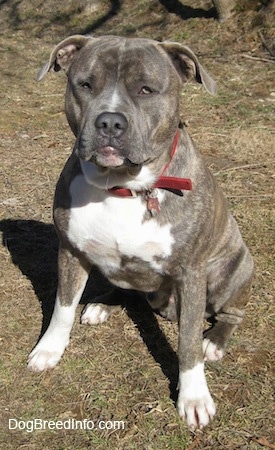
10 1/2 months old.
Getting Back in the Zone
Over the weekend Spencer was on a camping trip. Since there was two feet of snow everywhere with drifts of four feet with no houses and no sidewalks, only an icy dirt road and miles of woods, all of his exercise ended up being excited exercise.
Boy, did he get a lot of exercise, sledding with the kids and running in the snow off leash. We were able to walk on top of the snow a lot of the time but every once in a while your foot would sink down into the bottom layers making it hard to walk. We were camping with a group of people who didn't ask Spencer for the same level of respect and leadership that he is used to getting at home.
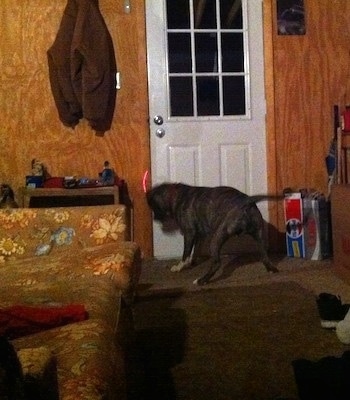
The last night we were there Spencer had been introduced to a laser light and went crazy trying to chase it. I noticed at that time that his tail, which is normally carried low, had gone up to the middle road. It was not up as far as it can go, but it was certainly up higher than he carries it the majority of the time. I was not so sure what to think at the time. I knew it was not a good thing but I didn't know if it would have longer lasting effects on his temperament.
The next morning when we got up to go home the little boy got his light out again and I watched Spencer's tail go up again as he started looking for the light. We asked that the light be put away, but Spencer was in "search mode" and was looking for the light for the next half-hour.
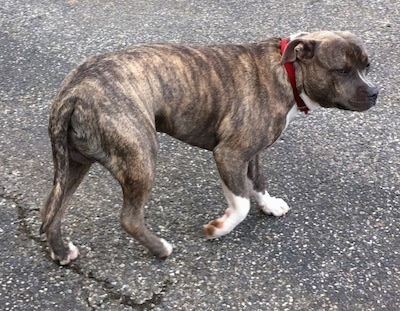
The next day I noticed something. The majority of the time Spencer's tail is usually relaxed and held down, like in the picture above. For the last couple of days, the end of the camping trip and the day we got back from the trip, the majority of the time Spencer's tail was sticking straight out and was not relaxed like it normally is. His tail will go back and forth and that is normal, but it went from being down most of the time to being rigid and sticking straight out the majority of the time.
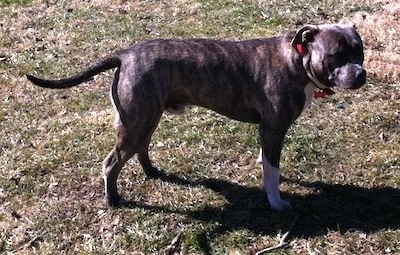
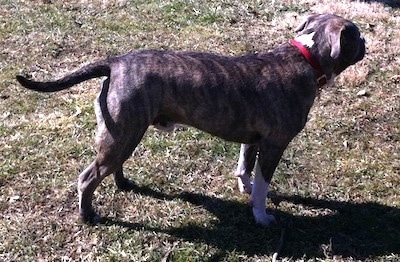
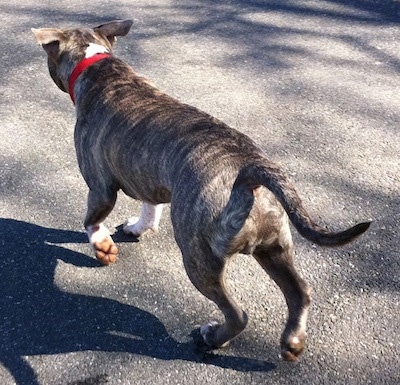
Get a load of the way he is carrying his tail. It's not too bad, it could be worse. I have seen his tail go all the way up when barking at something in the woods, but the way he is carrying himself is not the way he normally carries himself. See how the top part of the tail is up higher than his back and then it slopes down and curves out? Normally it is more relaxed, level with this back, and slanting down. It does not usually go up higher than his back and then down with the tip curling outward. This pup was carrying himself in a more dominant state and he was not listening as well as he normally does. It was taking a lot more effort on my part to get him to hear me, or care to listen to me.
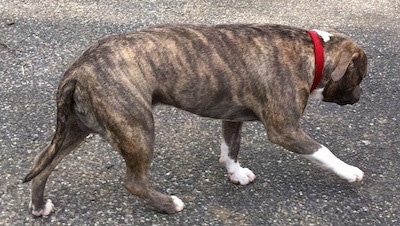
Here is an example of how is tail is carried low the majority of the time...
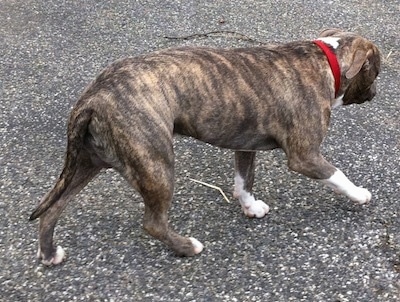
…compared to the heightened state above. You can see his shoulders are even more relaxed and carried lower than they are in the above heightened zone the pup had been stuck in since the camping trip.
His temperament changed a bit. Here are some examples:
We went for a walk in the goat field and Spencer chased the goats. He didn't stop with a voice command as he normally does. I had to walk toward him and toss a snowball in his direction to get him to hear me.
When I let him outside he spotted an animal part way up the driveway. I believe it was a deer; it was dark and I had a hard time seeing it. He could see it however and I told him to "leave it" and "stay," but he gave me a quick glance and took off running after it. Normally he would have listened to my voice command. Again his tail had been middle-of-the-road rather than down.
We went for a walk in the woods and he rolled on top of two different dead animals. Again he was running around with his tail middle-road, instead of down like it normally is. To get him to stop rolling I had to walk towards him. My normal voice commands were not working.
This pup was put into the excited zone over the weekend and needed to be snapped out of it. He needed a long pack walk where he heeled on the leash, but first things first. That dead animal smell had to be washed off of him because there was no way he was getting into my car smelling like that!
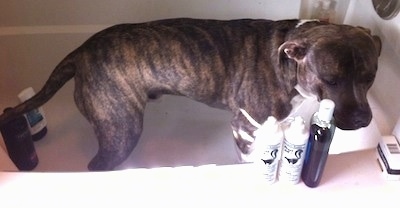
Even in the tub I noticed when Spencer first got in his tail was not relaxed.
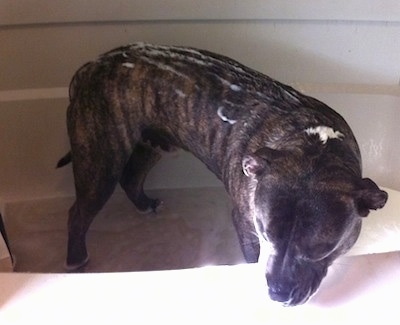
As I made my rules clear to him—he was not to jump out until I said he could—his tail relaxed and went down.
When it was time to get out of the tub and to leave the bathroom I made sure we did it respectfully. No rushing out of the bathroom like a crazy pup. I asked him to back up while I opened the door, then asked him to walk behind me as we left the room and went down the steps. He had to walk calmly down the steps to the living room being respectful not to run into me as we walked.
It is very obvious to me that if Spencer were not given pack walks and asked for respect the percentage of him listening as opposed to making his own decisions would spike up considerably. If Spencer normally walked around in that more dominant zone and we gave him affection and love it would make him even more dominant as it would be saying, good boy, how you are feeling is how we like you to feel.
Say What?
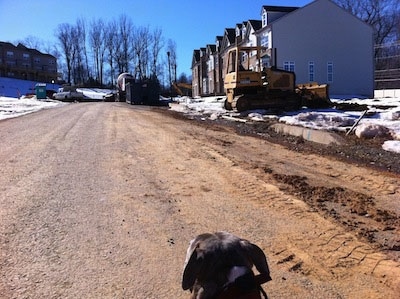
We walked past some more construction while out on one of our pack walks, a great way to socialize him with loud noises and activity. There were machines moving around and people banging things, but that didn't faze him at all. Neither did the three barking Pugs that were out walking their owner. The human on the other end of the leash says to the dogs in a soothing tone, "You're OK, you're OK" as we passed. I hear this reaction a lot from people out with their dogs. Very rarely do I hear a human tell a dog they don't agree with the way their dog is behaving. It's the tone dogs hear, not the words. Whatever the dog is doing at the moment you soothe it is what it thinks you agree with. It's like saying, “good dog for acting like that.”
Dog Approaching on Walk
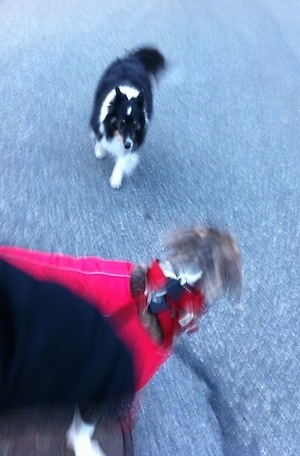
While out on a walk we get barked at a lot and Spencer does a great job ignoring the dogs. He looks, but he does not react. This particular dog barked at us from up at its house and then ran down the driveway and followed us up the road. I kept walking and Spencer kept turning to look but that was it. The dog smelled his back end and turned back toward home where its owner was calling. So far Spencer has never shown any type of aggression toward any other dog, even when the dogs are barking and growling at him. This particular dog meant no harm.
Spencer and Big Brother Bruno
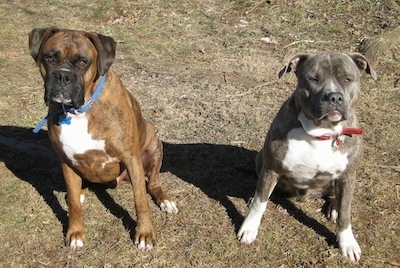
The Back Pack
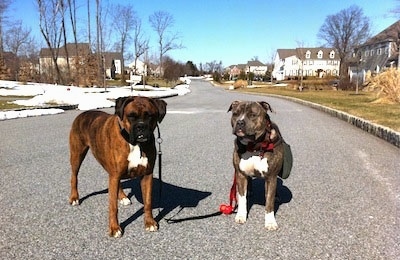
All of the recent ice and snow has been rough on the knee on which Bruno's had ACL surgery. We seemed to be covered in ice for over a month and while we walked him out to do his business very carefully, we ourselves were slipping. Bruno had been limping and his exercise was being limited. Now that things have melted enough to find some decent places to walk without having to walk over the slippery areas, we were off once again.
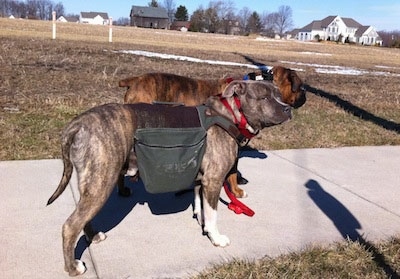
I wanted to walk slowly for Bruno's sake to get him back into things since he has been limping a bit in the last week and was just starting to feel better. I put a backpack on Spencer to not only slow him down but so he could get more out of our shorter walk. It worked like a charm. Spencer walked at Bruno's pace and was very tired when we were done. I had put a handful of unopened hand-warmer packets in the pouches of the backpack. Not a lot of weight but enough that the pup felt like he had a job to do. The pup is back in the calm zone since our recent camping trip and the laser light ordeal.
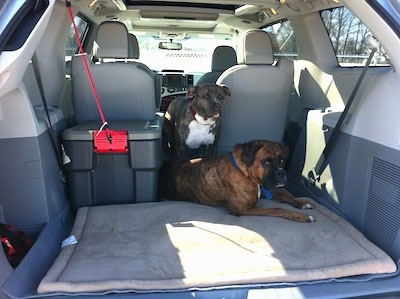
Back at the van the dogs are very calm. They both stay even when the hatch is open.
The Horses and Ponies
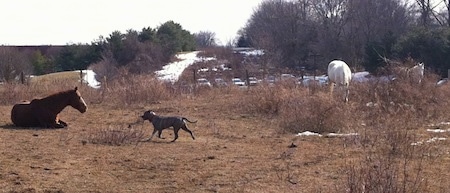
I walked Spencer into the upper horse field where a herd of ponies and a separate herd of horses live. We had not been in the field since the winter brought all of the snow and ice. Now that it’s all melting it was time to let the pup run. He is not allowed to chase the horses. It had been so long since he has seen them he went for it. He ran toward three of the ponies. Instead of running, however the ponies walked toward him as a group, all looking right at him. Spencer skidded in his tracks, turned and walked away. For the rest of the walk he showed all of the horses and ponies respect, only smelling one that was lying down but ignoring the rest. Many thanks to the ponies for putting him back in his place so I didn't have to.
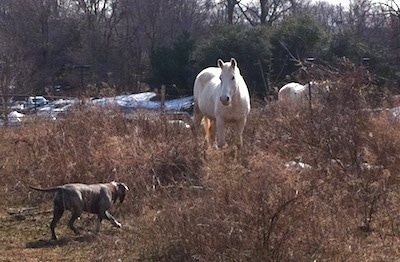
Notice his tail is level with his back and not higher. That tells me he was not being dominant toward the horses, just excited and curious. The horses didn't see him as a threat either. Horses are flight animals and run if they sense danger. None of the horses or ponies ran or kicked at him.
Communication in Dog Language
Spencer was outside doing his business. While he was peeing he was staring at something intensely and suddenly he took off running, heading right for the driveway. He was running fast and I mean fast. He got to the driveway and...the driveway gate was shut!! Burn on him!! I had known the gate was shut so I didn't even bother yelling for him to stop.
After the burn on the pup I had walked away to let Bruno do his business when I heard Spencer barking at something. I mean really barking. The kind of bark Allie, my old Boxer would do if there was a fox trapped in the cat house. I didn't tell Spencer to stop because I first wanted to see what it was. I thought for sure it was some kind of animal and not one that lived here. His bark was different. It was not a play bark and this was the first time I heard that type of bark coming from him. I walked over and saw a wild, feral cat on the swing set. Not one you can touch; it would most likely bite you if you tried. I looked at the cat and it was scared to death. I looked back at Spencer and he was in high-alert hunting mode with his tail up, very high and rigid. He looked at me and back at the cat and barked. I stood there for a second assessing the situation, then said to Spencer "come on" in my "I mean it" voice that has a strong emphasis to it; said with authority but very calmly with a growl to the tone. I leaned toward him to let him know I really meant it. The last thing I needed was a feral cat fight and the poor wild cat just wanted to get out of there.
Spencer lowered his tail and started to follow me away from the cat. As soon as he did I immediately turned away from him. I eased up on my posture and started heading toward the house so Spencer would know that's what I wanted. When he looked back at the cat I went back into mamma bear mode, leaned toward him and said "come on" in my growl voice. Spencer turned back to me and I immediately backed off and started walking back to the house. I could not help but smile as he left the cat behind and followed me. I didn't even have to take him by the collar. He just came with me.
In the house he went to the door and asked to go out. I knew he just wanted to chase the cat so I walked to his dog bed and said "come on." Spencer walked to me and I pointed to his bed. He plopped down on his bed and lay his head down to sleep.
The communication between us was awesome. I really felt we knew what one another was saying and I used limited words and more body language. Spencer's body language was that of a happy dog as he was walking away. When he was following me he had a gait of submissive joy. I never yelled at him and never touched him, everything was calm and to the point. "Wild cat! Yes, I see the cat. Thank you very much for showing me. Now let’s let it go. No, you are not going back out, go to bed." We said all of this without words yet we both knew.
I am practicing using fewer words and more body language with the dogs. It is a fun skill to practice, how to speak dog. Knowing when to back off is very important when communicating with a dog. As soon as they start doing what you want, or stop doing what you are asking them to stop, you must stop the correction. I turned sideways and stopped eye contact to tell him that was all I wanted. When he started thinking about it again I turn back toward him, leaned forward and used my body language with a grunt to say I didn't approve.
Calm Around Excited Humans
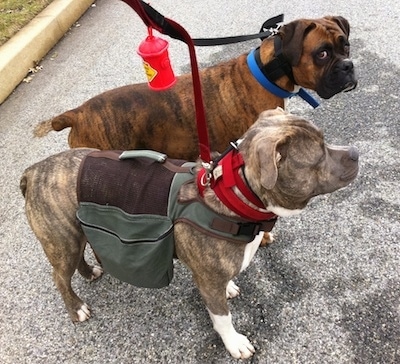
I am still working on Spencer not pulling when a human approaches us on a walk sweet-talking him. Bruno does a lot better, but sometimes not even he can resist. It gets Spencer very excited, out of his calm zone and he will try and pull toward them to say "hi." While Spencer's intentions are to just say hello, the pulling on the leash is very bad manners for any dog, even small ones. But even worse for his 80 pounds of muscle. He is too strong to be doing that. I just wish the humans also realized it's not really good manners to sweet-talk a dog that is on a leash. Some humans are even worse; there are those who call him to come to them in an excited tone while he is on the leash! Spencer will have to have some major will-power for him to resist the oohs and ahhs. It kind of seems to me that the real issue is trying to come up with a polite way to tell all of the human strangers we see in the streets to calm down when talking to him. More so than expecting Spencer not to react. I'll have to work on both the dog and trying to relay that to the humans.
Puppy No-No's
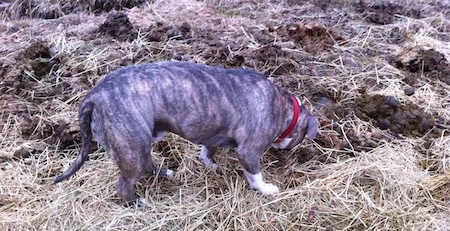
Oh my gosh, Spencer! Stop eating horse poop or you won't eat your breakfast!
Raising a Puppy: Spencer the Pit Bull




















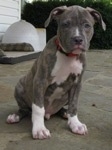
 Raising a Puppy: A day in the life with Spencer the Pit Bull puppy
Raising a Puppy: A day in the life with Spencer the Pit Bull puppy